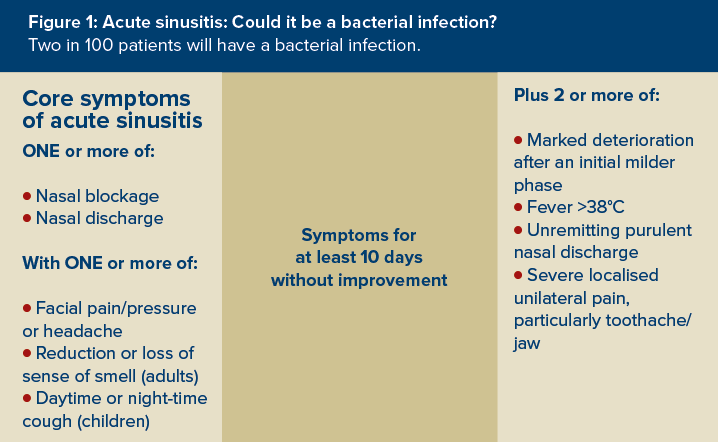When to suspect acute sinusitis
The presence of ONE of the following signs/symptoms suggests acute sinusitis:
- Nasal blockage (obstruction/congestion) OR
- Nasal discharge (anterior/posterior nasal drip).
AND ONE or more of the following:
- Facial pain/pressure (or headache) OR
- Reduction (or loss) of the sense of smell (in adults) OR
- Cough during the day or at night (in children).
There may be a reduction or loss of the sense of smell. Other features suggestive of acute sinusitis are altered speech indicating nasal obstruction, and tenderness, swelling or redness over the cheekbone or periorbital areas.
To diagnose sinusitis, symptoms should have been present for 10 days or more with little improvement.
Most cases of sinusitis are improving by day 10 and resolve in two to three weeks. Chronic sinusitis is defined as symptoms lasting for more than 12 weeks. Symptoms for around 10 days or less are more likely to be associated with a preceding cold rather than viral or bacterial acute sinusitis.
Associated symptoms include:
- The affected sinus often feels tender when pressure is applied. It is typically worse on bending forwards or lying down
- The pain may be felt behind and around the eye, or over the cheek, with radiation over the forehead and often only one side is affected
- The headache may be associated with runny nose or nasal congestion
- Fever (above 38°C) is usually an indication of bacterial infection.
If there has been a marked deterioration in sinusitis symptoms following a recent cold that had started to settle (so called ‘double sickening’) this may be an indication of bacterial infection. The features of a bacterial infection are summarised in Figure 1.
Key facts
- Most cases of acute sinusitis take two to three weeks to resolve and do not need treatment with antibiotics; many patients will be unaware of this
- Most cases are caused by viruses; only two in 100 cases will be complicated by bacterial infection
- NICE advises that even bacterial sinusitis is usually self-limiting and does not routinely need antibiotics
- Self care measures include analgesics and nasal saline irrigation
- Symptoms indicating bacterial infection are marked deterioration after an initial milder phase, fever (above 38°C), unremitting purulent nasal discharge, and severe unilateral pain (especially tooth and/or jaw pain).

